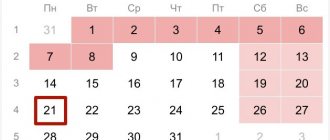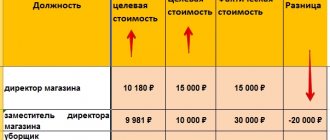Certain categories of workers
Oksana Lim
Expert in tax and labor relations
Current as of February 5, 2019
In some cases, a company needs to determine the value of the average headcount (ASH). Are part-time workers taken into account when calculating or should such workers be ignored? If this category of employees is taken into account, then in what order should this be done? These questions cannot be answered in a few words. Read the material about part-time workers to calculate the average number of employees.
Part-time workers: features of inclusion in the average number
Employees who have several jobs are included in the staff of the relevant organizations. Labor legislation does not limit a person’s right to perform multiple jobs. Each employee can find additional employment:
- at one more workplace in your organization and work as an internal part-time worker;
- to another organization, being in the status of an external part-time worker.
External part-time workers are subject to the requirements of the Labor Code and its guarantees. Like key employees, they enter into employment agreements with their employers. External part-time workers occupy positions that are contained in the staffing table.
On the other hand, they are also included in the staff of their main employer. It turns out that external part-time workers are included in the average salary of each enterprise where they continue to work? Everything is somewhat more complicated, and the calculation of the average frequency itself has features depending on its purpose and the period of reporting time.
Important! The algorithm depends on the reporting form that enterprises submit.
Who is a part-time worker according to the Labor Code of the Russian Federation?
The labor activities of part-time workers are regulated by the provisions of labor law, namely Chapter 44 of the Labor Code of the Russian Federation. In accordance with Art. 282 of the Labor Code of the Russian Federation, part-time work is recognized as the performance by an employee of other regular and paid functions on the basis of a signed employment contract. These job functions are performed during free time from performing primary duties.
Part-time workers can be both external and internal. Internal part-time work involves combining several positions within one organization. In practice, external part-time work also occurs, that is, an individual performs labor functions simultaneously in several companies (with several employers).
There is a certain group of working citizens in accordance with Art. 282 of the Labor Code of the Russian Federation, for which both external and internal combinations are prohibited. These include workers who have not reached the age of majority, as well as personnel employed in industries harmful to life and health.
Labor relations with a part-time worker must be documented. Depending on whether the part-time worker is external or internal, different documents may be drawn up. If an open vacancy is filled by a company employee, an additional agreement may be drawn up with this employee. For employees hired from outside, an employment contract must be drawn up. Also, at the request of the employee, an entry about part-time work can be made in the work book. However, there are certain nuances. The main employer must ensure storage of the document. If an employee has expressed a desire to include information about additional work in the book, he should provide the main employer with a copy of the employment contract. Based on this information, the employer enters information into the document.
SCH and part-time workers in the report according to f. 1-T
Each enterprise annually submits a report according to f. No. 1-T, which reflects information about the number and earnings of employees. It contains information about the average for the year.
Based on the Instructions (clause 6), which describe the features of filling out the document, the average is determined by summing the number of employees for each month and dividing the result by 12.
In column 4 f. No. 1-T states that the SC should not include external part-time workers and workers not included in the payroll.
Important! Therefore, they are not included in this report and are excluded from the NA.
Headcount
To calculate the average number of employees, you must first determine the number of employees for each calendar day of the reporting period (for example, a month - from the 1st to the 30th or 31st, and for February - to the 28th or 29th) . The payroll takes into account:
- employees signed under an employment contract who perform permanent, temporary or seasonal work for one day or more;
- owners of the company who work and receive salaries in it.
Moreover, they take into account both those actually working and those absent from work for some reason. Thus, the payroll includes:
- those who came to work, including those who did not work due to downtime;
- those who are on business trips if the company maintains their salaries, as well as those who are on short-term business trips abroad;
- who did not show up for work due to illness (during the entire sick leave and until retirement due to disability);
- who did not show up for work because they were performing state and public duties (for example, participating as a juror in court);
- hired with a probationary period, etc.
The full list of employees who are included in the payroll is given in paragraph 82 of Rosstat Order No. 278 dated November 12, 2008.
The following are not included in the payroll:
- hired part-time from other companies (their records are kept separately);
- performing work under civil law contracts (contracts, services, etc.);
- recruited to work under special contracts with government agencies for the provision of labor (military personnel or those serving a sentence of imprisonment). Moreover, they are taken into account in the average number;
- those who wrote for notice of dismissal and did not return to work before the notice period for dismissal expired (they are excluded from the workforce from the first day of absence from work);
- owners of the company who do not receive a salary from it;
- transferred to work in another company, if they do not retain their wages at their previous place of work, as well as those sent to work abroad;
- those sent for off-the-job training and receiving a stipend at the expense of the company that sent them;
- with whom a student agreement for vocational training has been concluded and who receive a scholarship during their studies;
- lawyers;
- members of the cooperative who have not entered into employment contracts with the company;
- military personnel.
The number of employees on the payroll is given not only for a specific date (for example, on the first or last day of the month), but also for the reporting period (for example, for a month, a quarter).
Please note: the average number is shown in whole units (for example, 1 person).
Data on the average in monthly reporting
In addition to data on the number of employees on average for the year, Rosstat, by order in September 2021, obliged enterprises to provide information monthly. This is what f is intended for. No. 4-P.
In gr. 2 reports should include data on the number of employees on the payroll without external part-time workers. To account for the number of the latter, column 3 is allocated. And in gr. 1, the data in the indicated columns are summarized. Thus, this report provides for the inclusion of external part-time workers in the SC. But it should be taken into account that their number is determined in proportion to the time they actually worked at a given enterprise.
| Types of part-time workers | Features of inclusion in the midrange |
| Domestic | Included in the MF as 1 unit |
| External | There are two options depending on the reporting form: 1. Not included in the calculation (form No. 1-T). 2. Are allocated in a separate column (form No. 4-P) and are included in the general SCH |
Important! As for internal part-time workers, they are counted only once as one person in any type of report.
Why is the average number of employees calculated?
No later than January 20, employers submit to their Federal Tax Service information on the average number of employees. This time the report must be submitted no later than January 21, 2021.
For more information, see “Deadline for submitting a report on the average headcount in 2019.”
In addition, the SSC is useful for:
- fill out the calculation of insurance premiums;
- draw up form 4-FSS;
- confirm the possibility of filing tax returns on paper (the right to submit reports on paper does not apply to VAT payers. Such companies are required to submit value added tax returns electronically, regardless of the number of employees);
- prepare statistical reports.
The procedure for calculating the number of external part-time workers
External part-time workers, as a rule, do not work full time. Therefore, to correctly calculate their average number, the time worked is taken as the basis. The algorithm includes:
- dividing the hours worked by part-time workers by the number of working days of the month;
- determining the average number of part-time workers monthly.
Example. In the reporting month (22 days), the company employed 3 external part-time workers. The standard working day is 8 hours. Part-time workers worked the following amount of time:
| Full name | Spent | |
| days | watch | |
| Kravtsov S. Ya. | 21 | 3 |
| Puchkov T. D. | 10 | 5 |
| Kubov M. L. | 21 | 4 |
The average number of external part-time workers can be calculated in two ways.
Method I
((21 · 3+10 · 5+ 21 · 4)/8)/22 = 1 person.
II method
(3/8 · 21+5/8 · 10+4/8 · 21) : 22 = 1 person.
In the reporting, three part-time workers will be reflected as one unit.
Important! The accountant independently chooses one of the calculation methods.
What number of employees is set as a criterion?
Let us say right away that the criterion for the number of employees is not just the number of employees in the organization, but an indicator such as the number of employees on average for the period from the beginning of the year to the reporting period inclusive. The procedure for calculating this indicator is established by paragraph 1 of Article 286 of the Tax Code. For clarity, we will reflect the calculation of this indicator by giving several formulas. Thus, the number of employees on average for the period from the beginning of the year to the reporting period inclusive is determined by the following formula:
| Number of employees on average for the period from the beginning of the year to the reporting period inclusive | = | Average number of employees for all months from the beginning of the year to the reporting period inclusive | / | Number of months from the beginning of the year to the reporting period inclusive |
In turn, the average number of employees per month is determined as follows:
| Average number of employees for each month | = | The number of employees of the organization on average per month (average monthly number)* | + |
| + | Average number of part-time workers with their main place of work with other employers (that is, external part-time workers) | + | Average number of persons performing work under civil contracts (including those concluded with legal entities providing services for hiring employees) |
* The average monthly payroll of an organization does not include employees on maternity leave, in connection with the adoption of a child under the age of 3 months, or caring for a child until he reaches the age of 3 years (clause 1 of article 286 NK).
Based on these formulas, in order to correctly calculate the average number of employees for the period from the beginning of the year to the reporting period, it is necessary to correctly determine for each month three components of the average number of employees:
1) the number of employees on average per month (average monthly number of employees);
2) the average number of external part-time workers;
3) the average number of employees working under civil contracts (for example, under contract agreements).
In turn, the rules for calculating the above-mentioned indicators are established by the Instructions for filling out labor indicators in state statistical observation forms, approved by Resolution of the Ministry of Statistics dated July 29, 2008 No. 92 (hereinafter referred to as Instructions No. 92), and are used both for statistical purposes and for application purposes USN.
We round the number of employees according to the rules of mathematics
When calculating the average number of employees, non-integer numbers may be obtained. In such cases, it is necessary to be guided by part two of paragraph 53 of the Instructions on the procedure for filling out tax returns (calculations) for taxes (duties), the purchase book, approved by the Ministry of Taxation Resolution No. 42 of December 24, 2014, according to which, for the purposes of applying the simplified tax system, the number of employees of the organization on average for the period from the beginning of the year to the reporting period inclusive, the average number of employees on the payroll per month, the average number of people working part-time with their main place of work for other employers, the average number of persons performing work under civil contracts, are taken rounded to the nearest whole number according to the rules of arithmetic . So, if the decimal part of the number is less than 0.5, then it is discarded, and if more than 0.5, it is rounded to 1. For example, if the calculated headcount was 14.62 people, then the headcount is 15 people, if 14.42 person - then 14 people).
Average monthly number of employees
When calculating the average monthly number of employees, you should be guided by paragraph 9 of Instructions No. 92. The general calculation formula is as follows:
| Average monthly headcount (including in cases where the organization operates for less than a full month) | = | The sum of the number of payroll employees (payroll number)* for each calendar day of the reporting month, that is, from the 1st to the 30th or 31st (for February - to the 28th or 29th), including public holidays , holidays (non-working days) and weekends | / | Number of calendar days of the reporting month |
* The organization’s payroll includes employees working under an employment agreement (contract) and performing permanent, temporary or seasonal work for 1 day or more (clause 3 of Instructions No. 92).
EXAMPLE
Calculation of the average monthly number of employees
The organization was registered on April 14 and has been applying the simplified tax system since the date of registration. The reporting period is a quarter. Data on the payroll and average monthly number of employees are presented in the table.
| Month | Period | Number of calendar days in the period | List number of employees in the period | Calculation of the average monthly number: (gr. 3 gr. 4) / / number of days in a month | Average monthly number of employees (persons) |
| 1 | 2 | 3 | 4 | 5 | 6 |
| April | From April 14 to April 30 | 17 | 5 | (17 x 5) / / 30 | 2,83 |
| May | From 1 to 18 May | 18 | 5 | (18 x 5 + + 13 10) / / 31 | 7,10 |
| From 19 to 31 May | 13 | 10 | |||
| June | From 1 to 11 June | 11 | 10 | (11 x 10 + + 14 x 15 + + 5 x 22) / 30 | 14,33 |
| From 12 to 25 June | 14 | 15 | |||
| From 26 to 30 June | 5 | 22 |
The average number of employees for the period from April (the month of registration) to June will be, taking into account rounding, 8 people ((2.83 people + 7.10 people + 14.33 people) / 3 months).
It must be said that not all categories of workers are taken into account in the payroll. Thus, according to paragraph 6 of Directive No. 92, the payroll does not include, in particular:
- external part-time workers;
- citizens who performed work under civil contracts. If a civil contract is concluded with an employee, then this employee is taken into account only in the payroll of the organization at the place of main work;
- employees who submitted a letter of resignation and stopped working without warning the employer or did not go to work before the expiration of the notice period established by law, as well as employees dismissed for absenteeism. They are excluded from the payroll from the first day of absence from work;
- owners (founders) of this organization who do not receive wages from it.
Who counts as one person
When determining the headcount, the following are taken into account as one person:
a) an employee hired on a part-time basis (part-time work week), at a part-time rate (salary) for each calendar day, including non-working days of the week, established for him upon hiring (subclause 4.3 of Instructions No. 92);
b) an employee who receives more or less one rate in one organization (including separate divisions) (subclause 6.1 of Instructions No. 92);
c) internal part-time worker (that is, an employee who performs work in one organization both under the main employment contract and part-time) (subclause 6.1 of Instructions No. 92).
Average number of external part-time workers
It is necessary to calculate the average number of external part-time workers in accordance with paragraph 11 of Instructions No. 92. This paragraph establishes that this indicator is calculated in accordance with subclause 10.4 of Instructions No. 92, namely, it is taken into account in proportion to the time worked . In this case, it is recommended to use two methods for calculating the average number of external part-time workers (let’s call them “calculated” and “simplified”).
"Calculation" method. With this method, the average number of external part-time workers is calculated using the following formulas:
| Average number of external part-time workers for the reporting period | = | Total number of man-days worked during the reporting period | / | Number of working days according to the calendar in the reporting period |
In turn, the total number of person-days worked for the reporting month is determined as follows:
| Total number of man-days worked for the reporting month | = | Total number of man-hours worked in the reporting month | / | Working hours* |
* The dependence of the length of the working day on the length of the working week established in the organization is reflected in the table:
| Length of working week (hours) | Duration of the working day with a 5-day working week (hours) | Length of working day with a 6-day working week (hours) |
| 40 | 8 | 6,67 |
| 35 | 7 | 5,83 |
| 30 | 6 | 5 |
| 23 | 4,6 | 3,83 |
EXAMPLE
Calculation of the average number of external part-time workers
An organization operating on a 40-hour work week has hired external part-time workers:
- from May 1 to May 31 - two people at 0.25 rates. Worked 21 days for 2 hours;
- from May 16 to May 31 - five people at 0.5 rates. Worked for 12 days, 4 hours each.
There are 21 working days in May.
Let's calculate the average number of external part-time workers for May:
1) Let's determine the total number of man-days worked:
(21 days x 2 hours x 2 people / 8 hours) + (12 days x 4 hours x 5 people / 8 hours) = 40.5 people/day;
2) Let’s determine the average number of external part-time workers for May:
40.5 people/day / 21 days = 2 people. (subject to rounding).
"Simplified" method. This method of calculating the average number of external part-time workers can be applied if their working hours are 4 hours a day. Such workers are counted as 0.5 people for each working day.
Note that, according to subclause 10.4 of Instructions No. 92, for days of vacation, absences (falling on working days according to the calendar), the number of man-hours worked when calculating the average number of external part-time workers conditionally includes hours on the previous working day.
Average number of employees working under civil contracts
The average number of employees working under civil contracts must be calculated in accordance with paragraph 12 of Instructions No. 92. This paragraph establishes that this indicator is calculated in accordance with paragraph 9 of Instructions No. 92 (see section “Average monthly number of employees” on page 19). We will not talk about this calculation procedure again; we will only note some nuances:
1) citizens performing work under civil contracts are counted for each calendar day as one person for the entire duration of this contract (unlike external part-time workers, who are counted in proportion to the time worked);
2) in the average number of citizens who performed work under civil contracts:
- not included:
a) employees who are on the payroll of an organization and who have entered into a civil contract to perform work in the same organization;
b) individual entrepreneur;
c) citizens who have entered into a civil contract for the creation of intellectual property;
- citizens performing work under civil law contracts are included, including those working in an organization under contracts concluded with legal entities, if the subject of the contract is the provision of services for the provision and hiring of workers (clause 1 of Article 286 of the Tax Code).
What else needs to be taken into account
When calculating the number of employees on average for the period from the beginning of the year to the reporting period inclusive, it is necessary to take into account the standards established by Chapter 34 of the Tax Code, namely:
1) the calculation of the number of employees is carried out for the organization as a whole, including branches, representative offices and its other separate divisions (clause 1 of Article 286 of the Tax Code);
2) organizations whose reporting period for tax under the simplified tax system is a quarter, the average number indicator is calculated quarterly, and organizations whose reporting period is a month - monthly;
3) organizations that apply the simplified tax system from the date of state registration determine the number of employees in the year of registration on average for the period from the 1st day of the month of application of the simplified tax system to the reporting period inclusive (unlike “old” organizations that determine the number of employees on average for the period from beginning of the year to the reporting period) (part two of paragraph 3 of Article 287 of the Tax Code).
Zhanna Dibrova, economist
Some questions and answers
Question 1. The company's economist is an internal part-time worker. He does the job of a cashier (0.5 rate). How to include it in the midrange correctly?
Answer. According to the requirements of regulatory documents, internal part-time workers are included in the SC once for their main position. Therefore, although the economist of the company actually occupies 1.5 staff units, he is listed in the report as 1. That is, a physical unit is included in the average, not a staff one.
Question 2. Is it necessary to separately calculate the average of internal part-time workers?
Answer. There is no such need. Their number is contained in the total net worth of employees. Their earnings are also determined by the total amount.
Errors in determining the midrange
The presence of a significant number of part-time workers at an enterprise can cause confusion in the calculation of the average and make it incorrect.
The following errors are common:
- An internal part-time worker is included in the SC twice.
- Incorrect calculation of the number of external part-time workers: their number is determined by the number of staffing positions occupied. The correct calculation is made taking into account the actual time worked.
- The company operates on a six-day basis. This means that the working day is 6.67 hours. The accountant, when calculating the number of external part-time workers, used the number 8, which is relevant for a five-day period.
Calculations must be carried out carefully to minimize the likelihood of such errors. This is important, since if they are identified, the company will have to pay an administrative fine.
Calculation of the average number of part-time employees
For reporting in Form P-4, it is necessary to separately calculate the average number of employees who are external part-time workers. The resulting value is entered in the third column of the form.
The calculation of the average number of external part-time workers is carried out in the following order:
- The sum of man-days is calculated. To do this, the amount of man-hours worked in the reporting month is divided by the length of the working day.
After this, the average number of part-time employees is calculated for the month for which reporting is submitted. To do this, the value of the indicator of man-days worked is divided by the number of working days in the reporting month. For days of sick leave, vacations, absences from work (which coincided with working days), the hours of the last working day are included in the value of man-hours worked.
Similar articles
- Are external part-time workers included in the average headcount?
- Are external part-time workers included in the average headcount?
- Part-time workers are included in the average number
- Are maternity workers included in the average number?
- Average number and average number - difference
Question to the expert
One of the employees at his main place of work works at 0.5 times the rate. He is also an internal part-timer at 0.25 rates. How to correctly include it in the calculation of the average?
Answer. An employee should be counted not as 0.75, but as 1 person, since the personnel index reflects personnel only in whole units. It does not matter that this employee works part-time and acts as an internal part-time worker.
Labor inspector G. A. Sizova
The methodology for calculating the average number and the algorithm for including part-time workers in it is being developed by Rosstat.
The basic principles remain unchanged, although some adjustments to the reporting forms are made from time to time. Rate the quality of the article. Your opinion is important to us:
How to understand - part-time or not part-time?
In order to correctly take into account part-time workers, we will learn to distinguish them from those who can also work part-time, but are not part-time workers.
Does not apply to part-time and part-time workers:
- Those for whom a “short day” is established on the basis of current legislation. If you look, there are quite a lot of such groups. First of all, these are “harmful” and “dangerous” workers, whose working conditions relate to the 3rd and 4th degree of risk. Both disabled workers and employees under 18 years of age have the right to a reduced work schedule. Working hours are often reduced for doctors, teachers and similar categories of workers (reductions are provided for by federal laws);
- Those who are forced to work part-time temporarily, at the initiative of the employer.
When calculating the average payroll, people from both of these groups are counted as whole units.
An employee who, by his own consent, has entered into an agreement with the employer for part-time work, without indicating the combination, is not considered a part-time worker. In this situation, the average headcount for such employees has its own calculation nuances.








